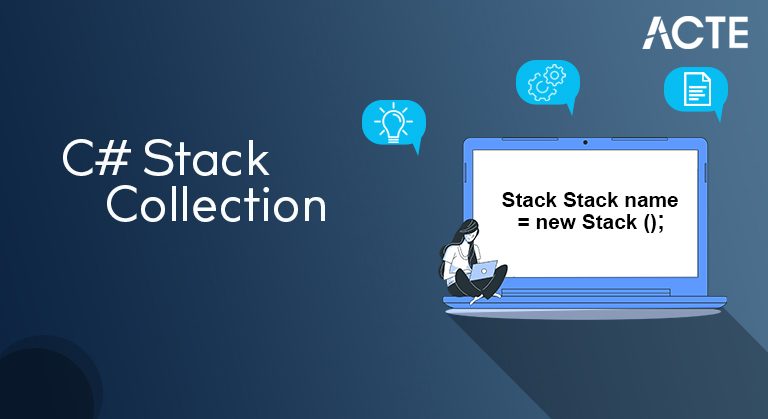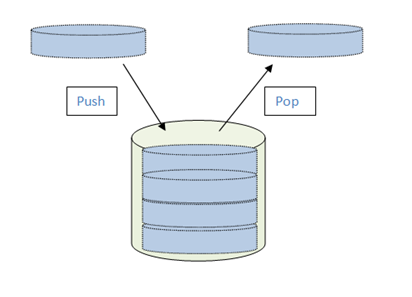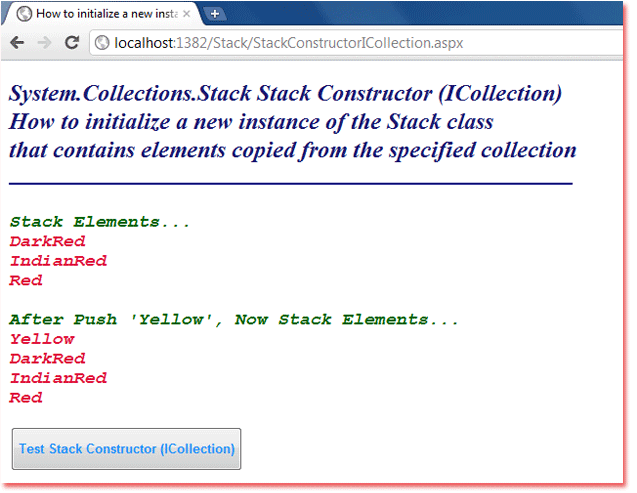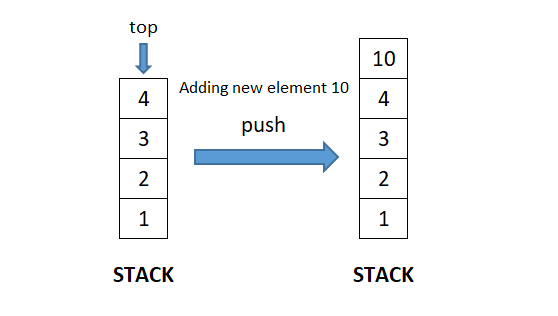
- Introduction to Stack Collection in C#
- Stack Collection in C#
- What is Generic Stack in C#?
- C# Stack Declaration
- C# Stack Overview
- Constructors in Stack Collection
- C# Stack with Examples
- Significant Points
- Stack<'T> Characteristics
- How to make a Stack?
- We should perceive how to make a stack utilizing Stack() constructor
- How to eliminate components from the Stack?
- How to get the highest component of the Stack?
- How to take a look at the accessibility of components in the stack?
- Structure
- The Advantage and Disadvantage of a stack in collection in C#
- Pre-necessities
- Conclusion
- A stack is a LIFO (toward the end in first out) information structure. Consider stacking an assortment of things where anything you embed in a stack will be set at the top and on the off chance that you want to eliminate something, it will be taken out from the top. A pile of plates or a book stack are two normal instances of a stack.
- In this instructional exercise, we will figure out how to utilize the Stack<'> class in C#. We will perceive how to make a Stack and how to utilize its Push, Pop, and different techniques. The Stack<'T> is an assortment that is characterized in the System.Collection.Generic namespace where T indicated the kind of components in the stack.
- Stack is an extraordinary kind of assortment that stores components in LIFO style (Last In First Out). C# incorporates the nonexclusive Stack<'T> and non-conventional Stack assortment classes. It is prescribed to utilize the nonexclusive Stack<'T> assortment.
- Stack is helpful to store brief information in LIFO style, and you should erase a component in the wake of recovering its worth.
- The Generic Stack in C# is an assortment class that chips away at the guideline of Last In First Out (LIFO) and this class is available in System.Collections.Generic namespace.
- This Stack assortment class is practically equivalent to a pile of plates. For instance, to add another plate to the heap of plates, then, at that point, we will just put it on top of the multitude of previously existing plates.
- Additionally, to eliminate a plate from the stack, then, at that point, we will just eliminate the one that we have last added. The stack assortment class likewise works in the comparable design. The last thing to be added (pushed) to the stack will be the main thing to be taken out (flew) from the stack.
- By and large, c# will uphold both conventional and non-nonexclusive sorts of stacks. Here, we will find out with regards to non-conventional line assortments by utilizing the System. Collections namespace so you can add components of various information types.
- As talked about, the assortment is a class, so to characterize a stack, you want to proclaim a case of the stack class before we play out many tasks like add, erase, and so on like as displayed underneath.
- Stack stk = new Stack();
- If you notice the above stack presentation, we made another stack (stk) with a case of stack class without determining any size.
- Coming up next are significant focuses that memorable need about the stack in c#.
- In c#, stacks are utilized to store an assortment of items in a LIFO (Last in, First out) style, i.e., the component which added last will come out first.By utilizing the Push() strategy, you can add components to the stack.
- The Pop() strategy will eliminate and return the highest component from the stack.
- The stack Peek() strategy will constantly return a last (top-most) embedded component of the stack, and it will not erase any component from the stack.
- The Stack Collection is utilized when the information things should be organized in a LIFO (Last In First Out) way. Whenever an information thing is gone into the assortment, it is known as a push. Whenever the information thing is taken out from the assortment, it is called pop.
- This constructor introduces another example of the Stack class that contains components replicated from the predefined assortment and has a similar introductory limit as the number of components duplicated.
- This constructor introduces another case of the Stack class that is unfilled and has the predefined starting limit or the default introductory limit, whichever is more noteworthy.
- The Stack class executes the IEnumerable, ICollection, and ICloneable connection points.
- Whenever you add a thing in the rundown, it is called pushing the component.
- Whenever you eliminate it, it is called popping the component.
- The limit of a Stack is the number of components the Stack can hold. As components are added to a Stack, the limit is consequently expanded as expected through redistribution.
- In Stack, you are permitted to store copy components.
- A Stack acknowledges invalid as a legitimate incentive for reference types.
- Stack<'T> is Last In First Out assortment.
- It goes under System.Collection.Generic namespace.
- Stack<'T> can contain components of the predetermined kind. It gives arrange time type checking and doesn’t perform boxing-unpacking because it is conventional.
- Components can be added utilizing the Push() technique. Can’t utilize assortment initializer grammar.
- Components can be recovered utilizing the Pop() and the Peek() techniques. It doesn’t uphold an indexer.
- utilizing System. Collections;
- Stack stack_name = new Stack();
- The limit of a Stack is the number of components the Stack can hold. As components are added to a Stack, the limit is naturally expanded as expected through redistribution.
- Assuming that Count is not exactly the limit of the stack, Push is an O(1) activity. Assuming that the limit should be expanded to oblige the new component, Push turns into an O(n) activity, where n is Count. Pop is an O(1) activity.
- Stack acknowledges invalid as a legitimate worth and permits copy components.
- 1) push() which adds a component to the highest point of the stack.
- 2) pop() which eliminates a component from the top of the stack.
- 3) find middle() which will return the center component of the stack.
- 4) deleteMiddle() which will erase the center component.
- In stack, the request in which the information shows up is significant. Stacks are great for authorizing consecutive principles of access i.e., LIFO.
- Stacks are utilized for switching things. If you push something, say a String onto a Stack each character in turn, and afterward build a String from the individuals flew off the Stack, then, at that point, the String is switched.
- Simple to begin
- Less Hardware Requirement
- Cross-Platform
- Assists you with dealing with the information in a Last In First Out (LIFO) technique which is preposterous with Linked rundown and exhibit.
- At the point when a capacity is known as the neighborhood factors are put away in a stack, and it is consequently
- Not adaptable
- Absence of scalability
- Unfit to Copy and Paste
- In light of dynamic memory allotment on the off chance that we did not utilize all memory space then there will be wastage of memory space.
- Public static (Shared in Visual Basic) individuals from this kind are string safe. Any example individuals are not destined to be string safe.
- To ensure the string security of the Stack, all tasks should be done through the covering returned by the Synchronized (Stack) strategy.
- Specifying through an assortment is characteristically not a string safe strategy. In any event, when an assortment is synchronized, different strings can in any case adjust the assortment, which makes the enumerator toss an exemption. To ensure string wellbeing during the list, you can either lock the assortment during the whole specification or discover the exemptions coming about because of changes made by different strings.
Introduction to Stack Collection in C#:
Stack Collection in C#:
The Stack Collection is utilized when the information things should be organized in a LIFO (Last In First Out) way. At the point when an information thing is gone into the assortment, it is called a push. Whenever the information thing is eliminated from the assortment, it is called pop.
C# – Stack<'T>:
Model,
The accompanying model exhibits utilization of Stack −
C# – Stack<'T> Stack is an exceptional kind of assortment that stores components in LIFO style (Last In First Out). C# incorporates the nonexclusive Stack<'T> and non-conventional Stack assortment classes. It is prescribed to utilize the nonexclusive Stack<'T> assortment.
The stack is an exceptional case assortment that addresses a toward the end in first out (LIFO) idea. Thus in C#, the stack additionally works similarly. Components are added to the stack, one on the highest point of one another. The most common way of adding a component to the stack is known as a push activity.
Push: Push in a stack implies adding components to the stack.
Pop: Pop in a stack implies eliminating a component from the stack.
Look: A Peek activity returns the last added component in the stack or the top component of the stack.

What is Generic Stack in C#?
C# Stack Declaration:
C# Stack Overview:
Constructors in Stack Collection:
The various constructors and their depiction is given as follows:
Table: Constructors in Stack Collection in C#
Source: MSDN
C# Stack with Examples:
A Stack addresses a rearward in, the first-out assortment of items. It is utilized when you want toward the end, first-out admittance to things. It is both a nonexclusive and non-conventional kind of assortment.
The nonexclusive stack is characterized in System.Collections.Generic namespace through the non-conventional stack is characterized under System. Collections namespace, here we will talk about non-conventional sort stack. A stack is utilized to make a unique assortment that develops, as indicated by the need of your program. In a stack, you can store components of similar sort or various sorts.
Significant Points:
Stack<'T> Characteristics:

How to make a Stack?
Stack class has three constructors which are utilized to make a stack which is as per the following:
Stack(): This constructor is utilized to make a case of the Stack class which is vacant and has the default introductory limit.
Stack(ICollection): This constructor is utilized to make an occasion of the Stack class which contains components duplicated from the predefined assortment, and has a similar beginning limit as the number of components replicated.
Stack(Int32): This constructor is utilized to make an example of the Stack class which is unfilled and has determined introductory limit or the default starting limit, whichever is more noteworthy.
We should perceive how to make a stack utilizing Stack() constructor:
Stage 1: Include System.Collections namespace in your program with the assistance of utilizing catchphrases.
Stage 2: Create a stack utilizing Stack class as displayed beneath:
Stage 3: If you need to add components to your stack, then, at that point, use Push() technique to add components in your stack. As displayed in the beneath model.
How to eliminate components from the Stack?
In Stack, you are permitted to eliminate components from the stack. The Stack class gives two distinct techniques to eliminate components and the strategies are:
Clear: This strategy is utilized to eliminate every one of the articles from the stack.
Pop: This technique eliminates the starting component of the stack.
Stack<'T>. Pop Method is utilized to eliminate and return the item at the highest point of the Stack<'T>. This strategy goes under the System.Collections.Generic namespace.
Stack addresses a rearward in, first out an assortment of articles. It is utilized when you really want a rearward in, first-out admittance to things. At the point when you add a thing in the rundown, it is called pushing the thing and when you eliminate it, it is called popping the thing. Stack<'T>. Clear Method is utilized to Removes all objects from the Stack<'T>. This technique is an O(n) activity, where n is Count.
Properties:
How to get the highest component of the Stack?
In Stack, you can without much of a stretch observe the highest component of the stack by utilizing the accompanying techniques given by the Stack class:
Step by step explanation :
Suppose the elements are pushed onto the stack in the order {4, 2, 14, 1, 18} .
Step 1 : Push 4, Current max : 4
Step 2 : Push 2, Current max : 4
Step 3 : Push 14, Current max : 14
Step 4 : Push 1, Current max : 14
Step 5 : Push 18, Current max : 18
Step 6 : Pop 18, Current max : 14
How to take a look at the accessibility of components in the stack?
In a stack, you can check whether or not the given component is available utilizing Contains () technique. Or then again as such, to look through a component in the given stack use Contains () technique. This technique returns valid assuming that the component is present in the stack. In any case, get back bogus.
Note: The Contains () strategy takes O(n) time to check on the off chance that the component exists in the stack. This ought to be thought about while utilizing this strategy.
How to carry out a stack which will uphold the following activities in O(1) time intricacy?
Structure:
In this program, the stack neighborhood variable is doled out to another Stack containing three numbers. The ints were added with the 10000 last. Next in Main the qualities are printed out to the Console. Stack addresses a toward the end in, first out assortment of item. It is utilized when you really want a rearward in, first-out admittance to things. At the point when you add a thing in the rundown, it is called pushing the thing and when you eliminate it, it is called popping the thing.
Tip: You can see that 10000 is shown first. This is clarified by the LIFO idea toward the end in first out.
LIFO: The last component added (with Push) to Stack is the first eliminated (with Pop).
Pop. Here we see the Pop technique on Stack and the Peek strategy. Whenever you call Pop, the components from the highest point of the Stack are returned, and the component is eliminated from the assortment.
Next: This model uses a similar Stack assortment as above, and that implies Pop brings 10000 back.
Too: It utilizes Peek, which does likewise as Pop yet doesn’t eliminate the component.
Pop and Peek both follow up on the highest point of Stack, meaning the component most as of late added. They likewise both return that top worth. Be that as it may, Peek doesn’t eliminate the component from the Stack assortment. It just gets the worth it “looks” at the worth.
Furthermore: Pop eliminates the reference. On the off chance that you call Pop, thereafter Peek and Pop will return the following worth when they are called.
Clear, count: You can utilize Clear and Count on your Stack. These strategies won’t raise special cases except if your Stack reference is invalid. The Count property is utilized without enclosure, while Clear() is a parameter less strategy.
Note: The model gets the Stack utilized in the above models, then, at that point, counts it, clears it, lastly counts it once more.
The Advantage and Disadvantage of a stack in collection in C#:
Advantage:
Disadvantage

Pre-necessities:
Conclusion:
This is a manual for C# Stack Collection. Here we additionally talk about the presentation and working of a stack in c # alongside various models and its code execution. it is a powerful assortment and components of both the same sort and various sorts can be put away in the stack and the most common way of adding a component to the stack.






